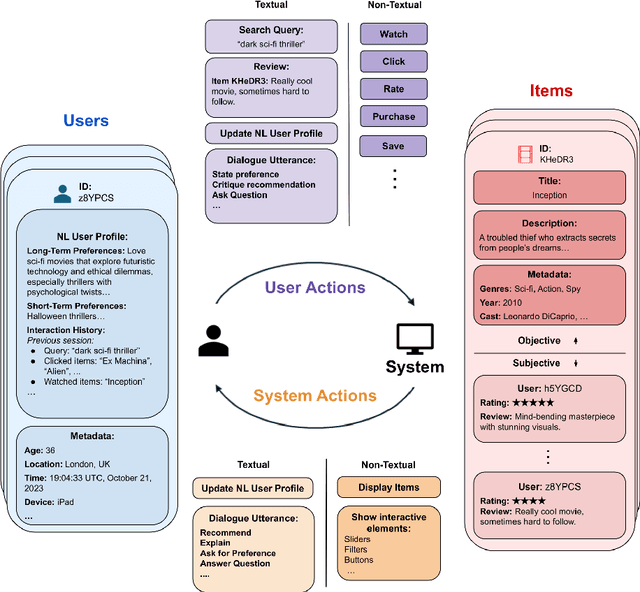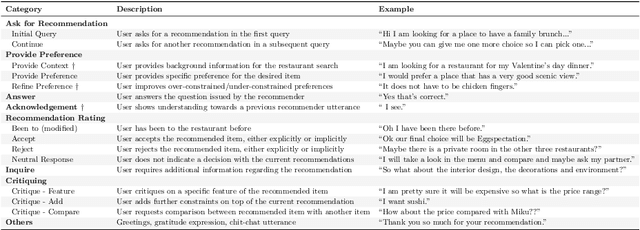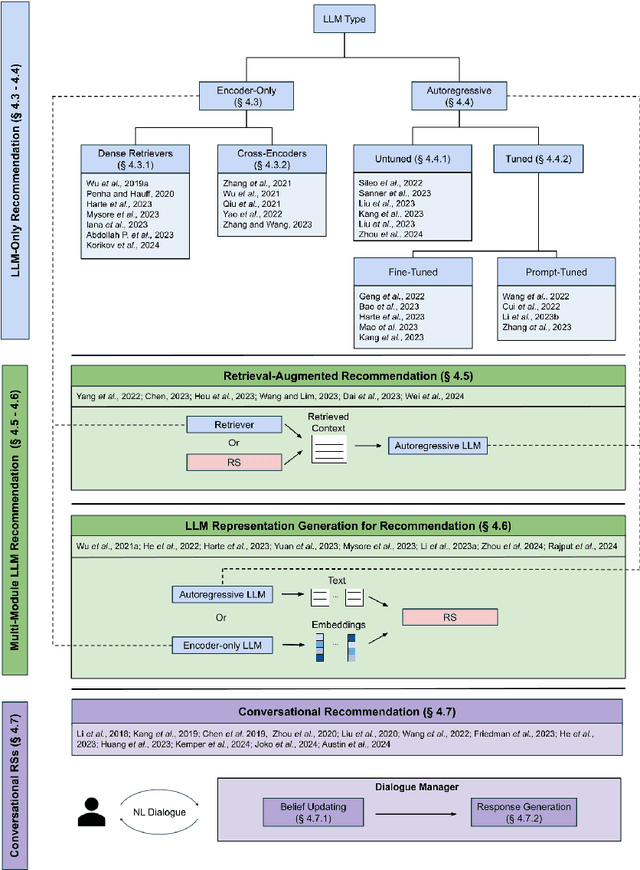Yashar Deldjoo
The Future is Agentic: Definitions, Perspectives, and Open Challenges of Multi-Agent Recommender Systems
Jul 02, 2025Abstract:Large language models (LLMs) are rapidly evolving from passive engines of text generation into agentic entities that can plan, remember, invoke external tools, and co-operate with one another. This perspective paper investigates how such LLM agents (and societies thereof) can transform the design space of recommender systems. We introduce a unified formalism that (i) models an individual agent as a tuple comprising its language core, tool set, and hierarchical memory, and (ii) captures a multi-agent recommender as a triple of agents, shared environment, and communication protocol. Within this framework, we present four end-to-end use cases-interactive party planning, synthetic user-simulation for offline evaluation, multi-modal furniture recommendation, and brand-aligned explanation generation-each illustrating a distinct capability unlocked by agentic orchestration. We then surface five cross-cutting challenge families: protocol complexity, scalability, hallucination and error propagation, emergent misalignment (including covert collusion), and brand compliance. For each, we formalize the problem, review nascent mitigation strategies, and outline open research questions. The result is both a blueprint and an agenda: a blueprint that shows how memory-augmented, tool-using LLM agents can be composed into robust recommendation pipelines, and an agenda inviting the RecSys community to develop benchmarks, theoretical guarantees, and governance tools that keep pace with this new degree of autonomy. By unifying agentic abstractions with recommender objectives, the paper lays the groundwork for the next generation of personalized, trustworthy, and context-rich recommendation services.
RAG-VisualRec: An Open Resource for Vision- and Text-Enhanced Retrieval-Augmented Generation in Recommendation
Jun 25, 2025Abstract:This paper addresses the challenge of developing multimodal recommender systems for the movie domain, where limited metadata (e.g., title, genre) often hinders the generation of robust recommendations. We introduce a resource that combines LLM-generated plot descriptions with trailer-derived visual embeddings in a unified pipeline supporting both Retrieval-Augmented Generation (RAG) and collaborative filtering. Central to our approach is a data augmentation step that transforms sparse metadata into richer textual signals, alongside fusion strategies (e.g., PCA, CCA) that integrate visual cues. Experimental evaluations demonstrate that CCA-based fusion significantly boosts recall compared to unimodal baselines, while an LLM-driven re-ranking step further improves NDCG, particularly in scenarios with limited textual data. By releasing this framework, we invite further exploration of multi-modal recommendation techniques tailored to cold-start, novelty-focused, and domain-specific settings. All code, data, and detailed documentation are publicly available at: https://github.com/RecSys-lab/RAG-VisualRec
Stealthy LLM-Driven Data Poisoning Attacks Against Embedding-Based Retrieval-Augmented Recommender Systems
May 08, 2025Abstract:We present a systematic study of provider-side data poisoning in retrieval-augmented recommender systems (RAG-based). By modifying only a small fraction of tokens within item descriptions -- for instance, adding emotional keywords or borrowing phrases from semantically related items -- an attacker can significantly promote or demote targeted items. We formalize these attacks under token-edit and semantic-similarity constraints, and we examine their effectiveness in both promotion (long-tail items) and demotion (short-head items) scenarios. Our experiments on MovieLens, using two large language model (LLM) retrieval modules, show that even subtle attacks shift final rankings and item exposures while eluding naive detection. The results underscore the vulnerability of RAG-based pipelines to small-scale metadata rewrites and emphasize the need for robust textual consistency checks and provenance tracking to thwart stealthy provider-side poisoning.
SynthTRIPs: A Knowledge-Grounded Framework for Benchmark Query Generation for Personalized Tourism Recommenders
Apr 12, 2025Abstract:Tourism Recommender Systems (TRS) are crucial in personalizing travel experiences by tailoring recommendations to users' preferences, constraints, and contextual factors. However, publicly available travel datasets often lack sufficient breadth and depth, limiting their ability to support advanced personalization strategies -- particularly for sustainable travel and off-peak tourism. In this work, we explore using Large Language Models (LLMs) to generate synthetic travel queries that emulate diverse user personas and incorporate structured filters such as budget constraints and sustainability preferences. This paper introduces a novel SynthTRIPs framework for generating synthetic travel queries using LLMs grounded in a curated knowledge base (KB). Our approach combines persona-based preferences (e.g., budget, travel style) with explicit sustainability filters (e.g., walkability, air quality) to produce realistic and diverse queries. We mitigate hallucination and ensure factual correctness by grounding the LLM responses in the KB. We formalize the query generation process and introduce evaluation metrics for assessing realism and alignment. Both human expert evaluations and automatic LLM-based assessments demonstrate the effectiveness of our synthetic dataset in capturing complex personalization aspects underrepresented in existing datasets. While our framework was developed and tested for personalized city trip recommendations, the methodology applies to other recommender system domains. Code and dataset are made public at https://bit.ly/synthTRIPs
Toward Holistic Evaluation of Recommender Systems Powered by Generative Models
Apr 09, 2025Abstract:Recommender systems powered by generative models (Gen-RecSys) extend beyond classical item ranking by producing open-ended content, which simultaneously unlocks richer user experiences and introduces new risks. On one hand, these systems can enhance personalization and appeal through dynamic explanations and multi-turn dialogues. On the other hand, they might venture into unknown territory-hallucinating nonexistent items, amplifying bias, or leaking private information. Traditional accuracy metrics cannot fully capture these challenges, as they fail to measure factual correctness, content safety, or alignment with user intent. This paper makes two main contributions. First, we categorize the evaluation challenges of Gen-RecSys into two groups: (i) existing concerns that are exacerbated by generative outputs (e.g., bias, privacy) and (ii) entirely new risks (e.g., item hallucinations, contradictory explanations). Second, we propose a holistic evaluation approach that includes scenario-based assessments and multi-metric checks-incorporating relevance, factual grounding, bias detection, and policy compliance. Our goal is to provide a guiding framework so researchers and practitioners can thoroughly assess Gen-RecSys, ensuring effective personalization and responsible deployment.
Use of Air Quality Sensor Network Data for Real-time Pollution-Aware POI Suggestion
Feb 13, 2025Abstract:This demo paper presents AirSense-R, a privacy-preserving mobile application that provides real-time, pollution-aware recommendations for points of interest (POIs) in urban environments. By combining real-time air quality monitoring data with user preferences, the proposed system aims to help users make health-conscious decisions about the locations they visit. The application utilizes collaborative filtering for personalized suggestions, and federated learning for privacy protection, and integrates air pollutant readings from AirSENCE sensor networks in cities such as Bari, Italy, and Cork, Ireland. Additionally, the AirSENCE prediction engine can be employed to detect anomaly readings and interpolate for air quality readings in areas with sparse sensor coverage. This system offers a promising, health-oriented POI recommendation solution that adapts dynamically to current urban air quality conditions while safeguarding user privacy. The code of AirTOWN and a demonstration video is made available at the following repo: https://github.com/AirtownApp/Airtown-Application.git.
AirTOWN: A Privacy-Preserving Mobile App for Real-time Pollution-Aware POI Suggestion
Jan 23, 2025Abstract:This demo paper presents \airtown, a privacy-preserving mobile application that provides real-time, pollution-aware recommendations for points of interest (POIs) in urban environments. By combining real-time Air Quality Index (AQI) data with user preferences, the proposed system aims to help users make health-conscious decisions about the locations they visit. The application utilizes collaborative filtering for personalized suggestions, and federated learning for privacy protection, and integrates AQI data from sensor networks in cities such as Bari, Italy, and Cork, UK. In areas with sparse sensor coverage, interpolation techniques approximate AQI values, ensuring broad applicability. This system offers a poromsing, health-oriented POI recommendation solution that adapts dynamically to current urban air quality conditions while safeguarding user privacy.
Poison-RAG: Adversarial Data Poisoning Attacks on Retrieval-Augmented Generation in Recommender Systems
Jan 20, 2025



Abstract:This study presents Poison-RAG, a framework for adversarial data poisoning attacks targeting retrieval-augmented generation (RAG)-based recommender systems. Poison-RAG manipulates item metadata, such as tags and descriptions, to influence recommendation outcomes. Using item metadata generated through a large language model (LLM) and embeddings derived via the OpenAI API, we explore the impact of adversarial poisoning attacks on provider-side, where attacks are designed to promote long-tail items and demote popular ones. Two attack strategies are proposed: local modifications, which personalize tags for each item using BERT embeddings, and global modifications, applying uniform tags across the dataset. Experiments conducted on the MovieLens dataset in a black-box setting reveal that local strategies improve manipulation effectiveness by up to 50\%, while global strategies risk boosting already popular items. Results indicate that popular items are more susceptible to attacks, whereas long-tail items are harder to manipulate. Approximately 70\% of items lack tags, presenting a cold-start challenge; data augmentation and synthesis are proposed as potential defense mechanisms to enhance RAG-based systems' resilience. The findings emphasize the need for robust metadata management to safeguard recommendation frameworks. Code and data are available at https://github.com/atenanaz/Poison-RAG.
Multi-modal Generative Models in Recommendation System
Sep 17, 2024



Abstract:Many recommendation systems limit user inputs to text strings or behavior signals such as clicks and purchases, and system outputs to a list of products sorted by relevance. With the advent of generative AI, users have come to expect richer levels of interactions. In visual search, for example, a user may provide a picture of their desired product along with a natural language modification of the content of the picture (e.g., a dress like the one shown in the picture but in red color). Moreover, users may want to better understand the recommendations they receive by visualizing how the product fits their use case, e.g., with a representation of how a garment might look on them, or how a furniture item might look in their room. Such advanced levels of interaction require recommendation systems that are able to discover both shared and complementary information about the product across modalities, and visualize the product in a realistic and informative way. However, existing systems often treat multiple modalities independently: text search is usually done by comparing the user query to product titles and descriptions, while visual search is typically done by comparing an image provided by the customer to product images. We argue that future recommendation systems will benefit from a multi-modal understanding of the products that leverages the rich information retailers have about both customers and products to come up with the best recommendations. In this chapter we review recommendation systems that use multiple data modalities simultaneously.
Large Language Model Driven Recommendation
Aug 20, 2024



Abstract:While previous chapters focused on recommendation systems (RSs) based on standardized, non-verbal user feedback such as purchases, views, and clicks -- the advent of LLMs has unlocked the use of natural language (NL) interactions for recommendation. This chapter discusses how LLMs' abilities for general NL reasoning present novel opportunities to build highly personalized RSs -- which can effectively connect nuanced and diverse user preferences to items, potentially via interactive dialogues. To begin this discussion, we first present a taxonomy of the key data sources for language-driven recommendation, covering item descriptions, user-system interactions, and user profiles. We then proceed to fundamental techniques for LLM recommendation, reviewing the use of encoder-only and autoregressive LLM recommendation in both tuned and untuned settings. Afterwards, we move to multi-module recommendation architectures in which LLMs interact with components such as retrievers and RSs in multi-stage pipelines. This brings us to architectures for conversational recommender systems (CRSs), in which LLMs facilitate multi-turn dialogues where each turn presents an opportunity not only to make recommendations, but also to engage with the user in interactive preference elicitation, critiquing, and question-answering.
 Add to Chrome
Add to Chrome Add to Firefox
Add to Firefox Add to Edge
Add to Edge